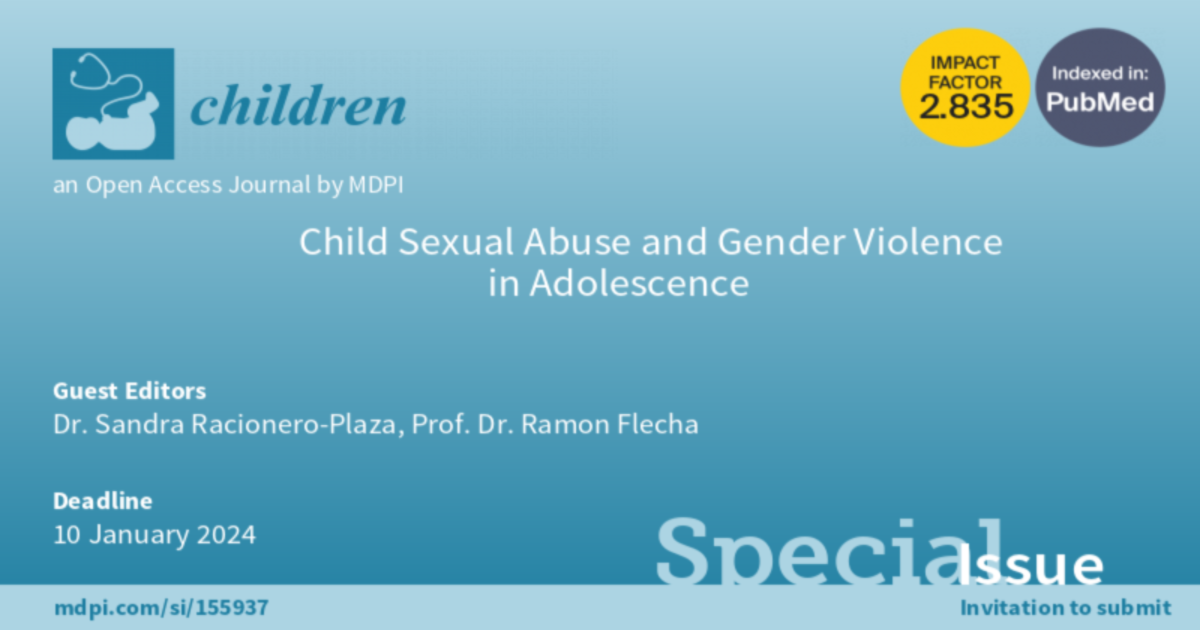Child Sexual Abuse and Gender Violence in Adolescence
A special issue of Children (ISSN 2227-9067). This special issue belongs to the section "Global and Public Health".
Deadline for manuscript submissions: closed (10 January 2024) | Viewed by 8630

Special Issue Editors
Interests: socioneuroscience applied to the elimination of gender violence and child sexual abuse; successful actions in safeguarding; violence against children; dialogic reconstruction of memories of sexual abuse
Interests: social impact of health research; gender based violence; healthy relationships and contexts; ethnic minorities and health; socioneuroscience
Special Issues, Collections and Topics in MDPI journals
Special Issue Information
Dear Colleagues,
The prevalence of child sexual abuse and gender violence in adolescence worldwide is alarming. The numbers are rising internationally, and the realms where this social problem manifests are very diverse: families, schools, sports clubs, pubs, parishes, NGOs, political parties, social media, etc. The health consequences of child sexual abuse and gender violence in adolescence are destructive regarding positive child and youth development, and as scientific research is already showing, they can lead to long-lasting negative health outcomes for the victims and their communities.
Considering this reality, this Special Issue aims to provide a scientific forum where to share, on the one hand, new advancements in the scientific understanding of child sexual abuse and gender violence victimization in adolescence and, on the other hand, empirical studies (quantitative, qualitative or mixed-methods) on successful prevention and response to such violence against children. It is of interest how these problems take place in diverse geographical and developmental contexts, including educational, family, nightlife, ecclesial, and online settings, among others. Interdisciplinarity is particularly welcome. The goal is to update the state of the art and disseminate successful actions and evidence-based solutions that society can use to address and eliminate this violence.
Dr. Sandra Racionero-Plaza
Prof. Dr. Ramon Flecha
Guest Editors
Manuscript Submission Information
Manuscripts should be submitted online at www.mdpi.com by registering and logging in to this website. Once you are registered, click here to go to the submission form. Manuscripts can be submitted until the deadline. All submissions that pass pre-check are peer-reviewed. Accepted papers will be published continuously in the journal (as soon as accepted) and will be listed together on the special issue website. Research articles, review articles as well as short communications are invited. For planned papers, a title and short abstract (about 100 words) can be sent to the Editorial Office for announcement on this website.
Submitted manuscripts should not have been published previously, nor be under consideration for publication elsewhere (except conference proceedings papers). All manuscripts are thoroughly refereed through a single-blind peer-review process. A guide for authors and other relevant information for submission of manuscripts is available on the Instructions for Authors page. Children is an international peer-reviewed open access monthly journal published by MDPI.
Please visit the Instructions for Authors page before submitting a manuscript. The Article Processing Charge (APC) for publication in this open access journal is 2400 CHF (Swiss Francs). Submitted papers should be well formatted and use good English. Authors may use MDPI's English editing service prior to publication or during author revisions.
Keywords
- child sexual abuse
- dating violence in adolescence
- gender violence in adolescence and youth
- (effective) safeguarding policies and programs
- prevention
- successful actions in overcoming child sexual abuse
- effective interventions
- effective training
- reconstruction of memories of sexual abuse and gender violence victimization in adolescence
- social impact in safeguarding







